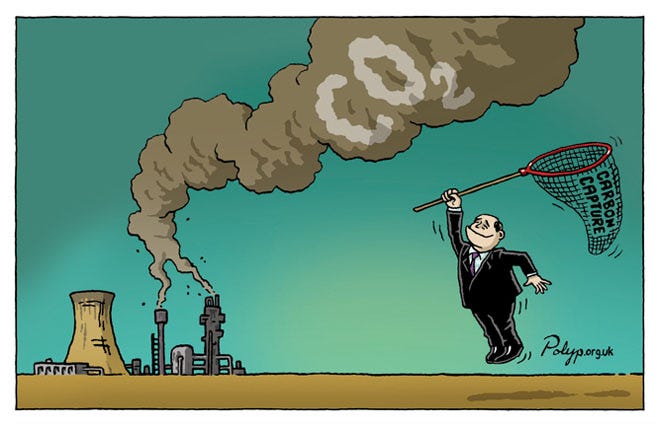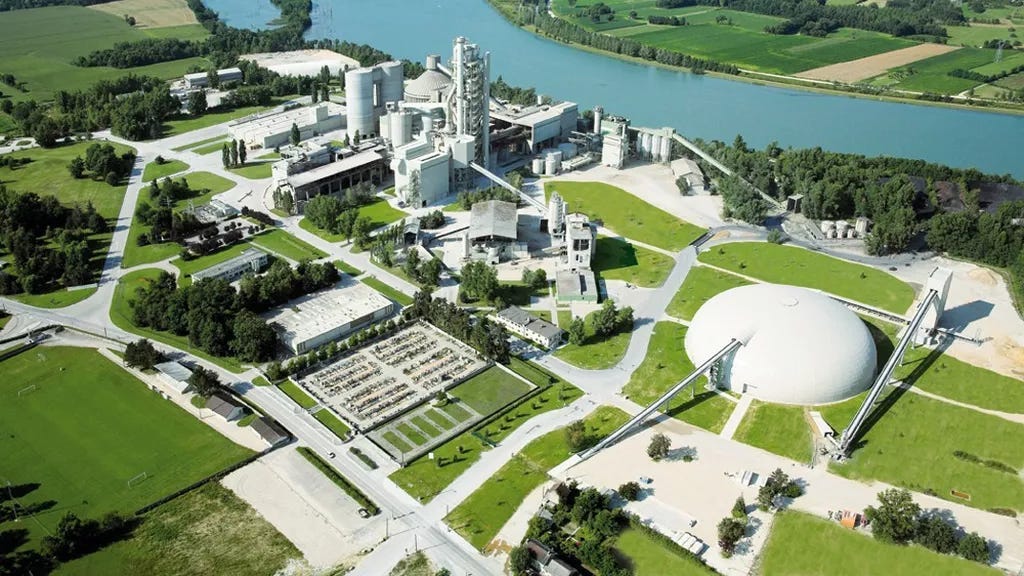Extracted/English version - Winter 2025 - Carbon capture : are we falling for a smokescreen?
International readers : this post is for you. French-speaking subscribers, we advise that you switch to the French version: https://exfiltrees.substack.com/
What do this prize launched by Elon Musk's X Foundation (with a USD 100 million target), this announcement by JP Morgan and this press release from the US Department of Energy have in common? The answer can be summed up in 3 letters: CCS (Carbon Capture & Storage).
Over the past few years, you couldn’t have missed the hype surrounding (more or less mature) carbon capture technologies. Long before the election of Donald Trump, messianic projects were springing up everywhere: one day we're hearing about “Frontier” (an initiative launched by Stripe, Alphabet, Meta, Shopify and McKinsey in 2022), then it's the “Deep Sky” project, a Canadian start-up for the direct capture of carbon from the air, which receives $40 million from a Bill Gates fund in 2024.
With the very significant acceleration of subsidies granted under the Inflation Reduction Act in the USA and the Fit for 55 package in Europe, public and private investment in CCS technologies have tripled in two years, reaching more than 6 billion in 2023 according to Bloomberg; and this figure continues to rise. However, the results are not (yet?) there, as the FT notes: “Few technologies have had so much money thrown at them for so many years by so many governments and companies, with such feeble results”.
So, miracle solution or far-fetched fantasy? How can we elucidate the monumental craze for CCS? These are the questions we tackle in this issue.
We hope you’ll enjoy reading, and many thanks to our new subscribers! Feel free to share your comments, remarks, and suggestions.
IN-DEPTH💡: Carbon captured?
What on earth is CCS?
Carbon capture and storage (CCS) technology encompasses several methods. While some of these technologies have existed for decades, their adoption has been limited, primarily due to high energy and water consumption, as well as prohibitive costs that have hindered development. However, new factors such as carbon taxes in Europe and public subsidies in the United States have reinvigorated the market. Among these methods:
Post-combustion capture: Currently the most mature technique, it involves capturing CO₂ after fossil fuel combustion. Factory emissions are mixed with a solvent that absorbs the gas before being transferred to a regeneration tower for high-temperature heating (an energy-intensive process) to extract the CO₂.
Source : PETRONAS FLOW
Pre-combustion capture : extracts CO₂ before combustion. This technique requires upstream modifications to plant infrastructure and is rarely used due to limited applications. However, this process has the advantage of being less energy-intensive and produces hydrogen, which can be used as an energy source.
Oxyfuel combustion : uses oxygen during fossil fuel combustion, producing a highly concentrated CO₂ flue gas, which facilitates its capture.
Direct Air Capture (DAC) : differs from other technologies by capturing carbon directly from the air. These installations can be completely decoupled from production sites. DAC poses additional technical challenges due to the low concentration of CO₂ in the air.
Transport and storage
Once captured, CO₂ must be condensed and transported. This can be done through pipelines, ships, or trucks for smaller quantities. The captured CO₂ is typically stored in deep geological formations, often offshore. This approach is preferred due to local populations' reluctance to have storage sites near their homes. However, establishing this infrastructure and geological sequestration sites is costly, time-consuming, and has a significant environmental impact, including water usage and drilling.
Alternative technologies are being developed to address geological storage issues. For instance, the Icelandic startup Carbfix has pioneered a method of turning CO₂ into stone by injecting it into basaltic rock formations.
Alternative technologies are being developed to address geological storage issues. For instance, the Icelandic startup Carb Fix has pioneered a method of turning CO₂ into stone by injecting it into basaltic rock formations.
Let’s look at some real-world examples
The world's largest "CO₂ vacuum cleaner" (DAC technology) is located in Mammoth (Iceland): Developed by the Swiss startup Climeworks, this site, based on a dormant volcano, was inaugurated in 2024 and can capture 36,000 tonnes of CO₂ per year (equivalent to the CO₂ emissions generated by about 4,000 households in France over a year). The plant uses giant fans to suck in air and capture CO₂, which is then stored underground in basaltic rocks at a depth of one kilometer. To better understand how it works, we recommend this short BBC clip Inside the Icelandic plant turning CO₂ into rocks.
Bantam (Oklahoma). In the United States, the largest carbon capture site was also inaugurated during the summer of 2024. Designed to capture more than 5,000 tonnes of CO₂ per year, the technology removes it from the atmosphere by heating limestone extracted from a quarry, which releases calcium oxide. This calcium oxide is then exposed to the air, where it acts as an absorbent to capture CO₂. The captured carbon is then reused in the oil extraction process. Other oil-producing states, such as Texas and Louisiana, are developing mega-capture projects, supported by millions of dollars in investment.
In France, there are a few existing/developing sites funded by industrial actors. Notable examples include ArcelorMittal, which has been experimenting with CO₂ capture at its Dunkirk site since 2022, or Vicat, which plans to capture 1 million tonnes of CO₂ per year at its Montalieu-Vercieu site, the largest cement plant in France.
(photo credit: Vicat and les Echos)
To sum up: despite the huge investments, the installations in place remain relatively few, energy-intensive and experimental.
This sounds rather disappointing, but to what extent is CCS a necessary step on the road to carbon neutrality? Can it be environmentally and financially profitable?
A Necessary Step Towards Carbon Neutrality by 2050 - But to What Extent?
In its roadmap "Net Zero by 2050" published in May 2021, the International Energy Agency (IEA) estimated that annual carbon capture should reach 4 billion tonnes of CO₂ by 2035 and 7.6 billion tonnes by 2050 (20% of current emissions) to achieve carbon neutrality by 2050. This would represent nearly 10% of the required emissions reduction effort.
However, with current annual capture of 50 million tonnes (Mt) (less than 1% of emissions), we are far from the target: current CCS capacities would need to increase by a factor of over 100! According to the latest IEA figures, despite exponential growth, announced projects would only bring global annual capture capacities to 435 Mt by 2030, and 625 Mt for storage. This represents only 40% (capture) and 60% (storage) of the figures needed for the 2050 carbon neutrality scenario.
Capacity of current and planned large-scale CO₂ capture projects vs. the Net Zero Scenario, 2020-2030 (Mt CO₂)
What about the financial and ecological viability?
The financing challenge of these projects raises crucial questions about profitability, both financially and in terms of emissions reduction efforts. Investments have seen exponential growth in recent years, particularly in the United States. Growth rates of 15-20% per year are expected in the next decade, with a large portion of these investments coming directly from public funding through subsidies and tax credits:
However, the history of CCS is marked by exponential costs, fragile profitability models due to fluctuating and low carbon prices, and an inability to deliver tangible industrial results. According to Wood Mackenzie, 68 initiated projects were abandoned due to lack of profitability, while 41 were operational in 2023. While some temper these failures by emphasizing the need to invest in improving current processes, the technology behind capture and storage is not new, and there are already several decades of history demonstrating the lack of economic viability and operational obstacles.
Bloomberg estimates that for carbon-intensive industries (ammonia, ethanol, natural gas), the capture cost per tonne would be between $20 and $28, and higher for industries such as cement ($79) or hydrogen and steel ($72). Adding transport and storage costs of $20-50 per tonne (4 times more in liquid form), the total cost reaches $92-130 or €88-125 - well above current prices in Europe (€70-80 per tonne) and far higher than carbon credit prices currently averaging less than €5 per tonne. For direct air capture technologies, costs exceed €1000 per tonne. For comparison, one ton of carbon is captured on average by 40 growing trees each year.
The MIT Technology Review's figure is stark: even if we could reduce CCS costs to $100 per tonne, it would require $22 trillion in investments to reduce warming by just 0.1°C!
These obstacles are compounded by local population acceptance issues, which could force projects towards more expensive solutions like offshore storage. Ultimately, it is much more effective, even from a strictly climate perspective, to act upstream on emissions reduction, preservation of natural sinks, and renewable energies.
Darker Motives?
It's crucial to note that oil industry players, who currently "capture" a significant portion of subsidies in this field, have long used this technology without environmental concerns. Indeed, injecting CO₂ (a byproduct of methane purification) into wells increases the amount of oil extracted from deposits, resulting in a negative overall climate impact. In 2021, this represented between two-thirds and three-quarters of CO₂ captured in the United States. Moreover, according to IRS regulations granting most tax credits, these will not be challenged as long as the captured CO₂ remains stored for at least 3 years (far from 2050!).
Beyond monopolizing subsidies to extract more oil, the narrative of highly carbon-intensive sectors around CCUS ("U" for utilization) legitimizes continued exploration and capacity expansion, arguing that innovation in the field will ultimately capture the greenhouse gases we continue to emit. Local elected officials in the concerned American states have well understood it, advocating for the maintenance of subsidy programs ($66 billion over 10 years in tax credits) despite Donald Trump's climate skepticism.
In a nutshell
Carbon capture and storage technology will be necessary to achieve carbon neutrality by 2050. However, it faces significant challenges in terms of scale, cost, and social acceptability - it is currently more cost-effective to be more sober, or invest in decarbonization through renewable energies and energy efficiency measures, both financially and climate-wise. A large portion of subsidies allocated to develop CC(U)S technologies are currently awarded to major fossil fuel players without real long-term performance obligations, risking a delay in decarbonization by justifying the continuation of "business-as-usual".
Liked this article? Share it!
💚Book of the month : World without end - really?
Now that political leaders of the USA believe climate change is a hoax and that economic growth can be infinite, let’s spread the word in an original way. In case you’ve missed it, the French best-selling graphic novel “World without end” by engineer and climate and energy expert Jean-Marc Jancovici and illustrator Christophe Blain has been translated and adapted for English speakers.
From resource depletion to climate change, this book offers a comprehensive look at our energy-dependent world and its future, using the form of a Socratic dialogue that will undoubtedly enrich your perspective.
And offering a graphic novel is surely much better received than forwarding yet another article about the climate catastrophe 😉
Did you enjoy this newsletter? Feel free to subscribe to receive the next issues!
Sources
https://www.nytimes.com/2024/09/20/us/politics/carbon-capture-irs-subsidies.html
https://bonpote.com/capture-et-elimination-du-carbone-arnaque-ou-solution-pour-le-climat/












